Pothole
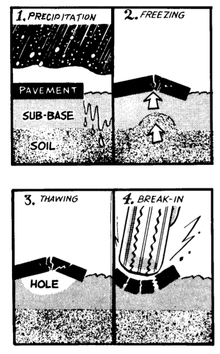
A pothole is a structural failure in an asphalt pavement,[1] caused by the presence of water in the underlying soil structure and the presence of traffic passing over the affected area. Introduction of water to the underlying soil structure first weakens the supporting soil. Traffic then fatigues and breaks the poorly supported asphalt surface in the affected area. Continued traffic action ejects both asphalt and the underlying soil material to create a hole in the pavement.
Formation
According to a U.S. Army Corps of Engineers publication, Pothole primer—A public administrator's guide to understanding and managing the pothole problem, (Eaton, et al.), pothole formation requires two factors to be present at the same time: water and traffic. Water weakens the soil beneath the pavement; traffic applies the loads that stress the pavement past the breaking point. Potholes form progressively, first from fatigue of the road surface, which can lead to a precursor failure pattern known as crocodile cracking. Finally, chunks of pavement between the fatigue cracks gradually work loose, and may eventually be plucked or forced out of the surface by continued wheel loads to create a pothole.[2]
In areas subject to freezing and thawing, frost heaving can damage a pavement and create openings for water to enter. Spring thaw of pavements accelerates this process when thawing of upper portions of the soil structure in a pavement cannot drain past still-frozen lower layers, thus saturating the supporting soil and weakening it.[2]
Potholes can grow to several feet in width, though they usually only develop to depths of a few inches. If they become large enough, damage to tires, wheels, and vehicle suspensions is liable to occur. Serious road accidents can occur as a direct result, especially on those roads where vehicle speeds are greater.[2]
According to Eaton, et al., potholes may result from four main causes:[2]
- 1. Insufficient pavement thickness to support traffic during freeze/thaw periods without localized failures.
- 2. Insufficient drainage.
- 3. Failures at utility trenches and castings (manhole and drain casings).
- 4. Miscellaneous pavement defects and cracks left unmaintained and unsealed so as to admit moisture and compromise the structural integrity of the pavement.
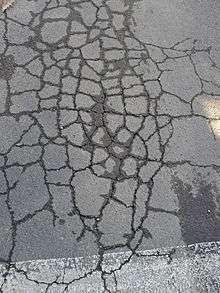 Crocodile cracking showing moisture seepage, a sign of a weakened soil structure beneath the failed asphalt.
Crocodile cracking showing moisture seepage, a sign of a weakened soil structure beneath the failed asphalt.
- Example of a pothole reappearing on a newly patched roadway, also showing the transition between crocodile cracking and the pothole, with water dried up, in a road on the Isle of Man.
 Small potholes, showing isolated failures of the pavement and its subsurface structure, in a road in Banbury, UK.
Small potholes, showing isolated failures of the pavement and its subsurface structure, in a road in Banbury, UK.- Potholes on an unpaved road in Sweden.
Prevention
Eaton, et al. cite the following steps to avoid pothole formation in existing pavements:[2]
- 1. Surveying of pavements for risk factors.
- 2. Providing adequate drainage structures.
- 3. Preventative maintenance.
- 4. Utility cut management.
Survey of pavements
At-risk pavement are more often local roads with lower structural standards and more complicating factors, like underground utilities, than major arteries. Pavement condition monitoring can lead to timely preventative action. Surveys address pavement distresses, which both diminishes the strength of the asphalt layer and admits water into the pavement, and effective drainage of water from within and around the pavement structure.
Drainage
Drainage structures, including ditching and storm sewers are essential for removing water from pavements. Avoiding other risk factors with good construction includes well-draining base and sub-base soils that avoid frost action and promote drying of the soil structure. Adequate crowns promote drainage to the sides. Good crack control prevents water penetration into the pavement soil structure.
Preventative maintenance
Preventative maintenance adds maintaining pavement structural integrity with thickness and continuity to the mix of preventing water penetration and promoting water migration away from the roadway.
Utility cut management
Eaton, et al., advocate a permitting process for utility cuts with specifications that avoid loss of structural continuity of pavements and flaws or failures that allow water penetration.
Repair
Pothole patching methods fall into two distinct categories: temporary and semi-permanent. Temporary patching is reserved for weather conditions that are not favorable to a more permanent solution and usually uses a cold mix asphalt patching compound placed in an expedient manner to temporarily restore pavement smoothness. Semi-permanent patching uses more care in reconstructing the perimeter of the failed area to blend with the surrounding pavement and usually employs a hot-mix asphalt fill above replacement of appropriate base materials.
The Federal Highway Administration (FHWA) Materials and Procedures for Repair of Potholes in Asphalt-Surfaced Pavements—Manual of Practice offers a comprehensive overview of best practices.[3] It cites several repair techniques: throw-and-roll, semi-permanent, spray injection, and edge seal, which are explained below. The FHWA suggests the best patching techniques at times other than winter are spray injection, or by the throw-and-roll, semi-permanent, or edge seal procedures. In winter, the throw-and-roll technique may be the only available option. The guidance from the Council for Scientific and Industrial Research in South Africa offers similar methods for the repair of potholes.[4]
Materials
Asphaltic patch materials consist of a binder and aggregate that come in two broad categories, hot mix and cold mix. Hot mixes are used by some agencies, they are produced at local asphalt plants.[2] The FHWA manual cites three types of cold mixes, those produced by a local asphalt plant, either 1) using the available aggregate and binder or 2) according to specifications set by the agency that will use the mix. The third type is a proprietary cold mix, which is manufactured to an advertised standard.[3]
Throw-and-roll repair
The FHWA manual[3] cites the throw-and-roll method as the most basic method, best used as a temporary repair under conditions when it is difficult to control the placement of material, such as winter-time. It consists of:
- 1. Placing the hot or cold patch material into a pothole.
- 2. Compacting the patch with a vehicle, such as a truck
- 3. Achieving a crown on the compacted patch of between 3 and 6 mm.
This method is widely used due to its simplicity and speed, especially as an expedient method when the material is placed under unfavorable conditions of water or temperature. It can also be employed at times when the pothole is dry and clean with more lasting results.[5] Eaton, et al., noted that the failure rate of expedient repairs is high and that and they can cost as much as five times the cost of properly done repairs. They advocate this type of repair only when weather conditions prevent proper techniques.[2]
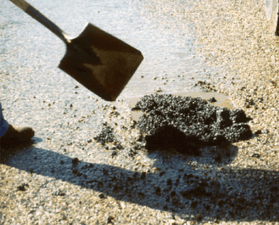 Throw-and-roll pothole repair procedure—material placement.
Throw-and-roll pothole repair procedure—material placement. Throw-and-roll pothole repair procedure—compaction of patch.
Throw-and-roll pothole repair procedure—compaction of patch.
Semi-permanent repair
The FHWA manual[3] cites the semi-permanent repair method as one of the best for repairing potholes, short of full-depth roadway replacement. It consists of:
- 1. Removing water and debris from the pothole.
- 2. Making clean cuts along the sides of prospective patch area to assure that vertical sides of the repair are in sound pavement. (Eaton, et al.,[2] recommend a bituminous tack coat in the open cavity, prior to placement of patch material.)
- 3. Placing the hot or cold patch mix material.
- 4. Compacting the patch with a device that is smaller than the patch area, e.g. vibratory rollers or a vibratory plate.
While this repair procedure provides durable results, it requires more labor and is more equipment-intensive than the throw-and-roll or the spray-injection procedure.
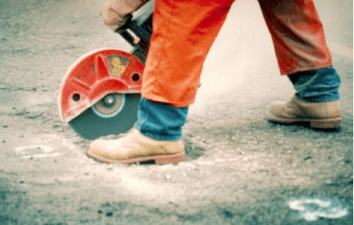 Semi-permanent pothole repair procedure—straightening edges using hand-held pavement saw.
Semi-permanent pothole repair procedure—straightening edges using hand-held pavement saw.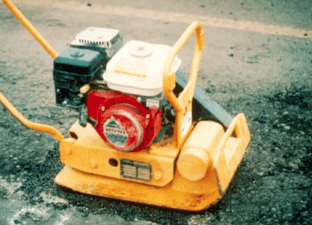 Semi-permanent pothole repair procedure—compaction using vibratory-plate compactor.
Semi-permanent pothole repair procedure—compaction using vibratory-plate compactor.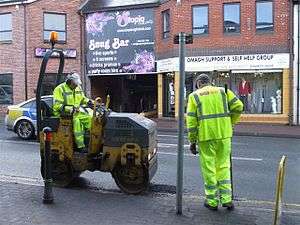 Semi-permanent pothole repair procedure—small vibratory compactor for larger repairs.
Semi-permanent pothole repair procedure—small vibratory compactor for larger repairs.
Spray-injection repair
The FHWA manual[3] cites the spray-injection procedure as an efficient alternative to semi-permanent repair. It requires specialized equipment, however. It consists of:
- 1. Blowing water and debris from the pothole.
- 2. Spraying a tack coat of binder on the sides and bottom of the pothole.
- 3. Blowing asphalt and aggregate into the pothole.
- 4. Covering the patched area with a layer of aggregate.
This procedure requires no compaction after the cover aggregate has been placed.
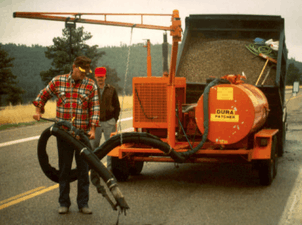 Spray-injection device for pothole repair—truck and trailer unit in the United States.
Spray-injection device for pothole repair—truck and trailer unit in the United States.- Spray-injection device for pothole repair—all-in-one repair unit in Montreal, which allows the operator to work from the comfort and safety of the cab.
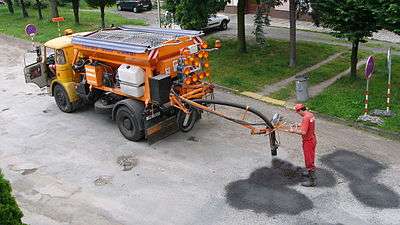 Spray-injection device for pothole repair—all-in-one repair unit in the Czech Republic.
Spray-injection device for pothole repair—all-in-one repair unit in the Czech Republic.
Edge seal repair
The FHWA manual[3] cites the edge seal method as an alternative to the above techniques. It consists of:
- 1. Following the "throw-and-roll" steps.
- 2. After the repaired section has dried, placing a ribbon of asphaltic tack material on top of the patch edge, overlapping the pavement and the patch.
- 3. Placing sand on the tack material to prevent tracking by vehicle tires.
In this procedure, waiting for any water to dry may require a second visit to place the tack coat. The tack material prevents water from getting through the edge of the patch and helps bond the patch to the surrounding pavement.
Efficacy of repair methods
An FHWA-sponsored study determined that the "throw-and-roll technique proved as effective as the semi-permanent procedure when the two procedures were compared directly, using similar materials". It also found the throw-and-roll procedure to be generally more cost-effective when using quality materials. It further found that spray-injection repairs were as effective as control patches, depending on the expertise of the equipment operator.[5]
Reporting
Some jurisdictions offer websites or mobile apps for pothole-reporting. These allow citizens to report potholes and other road hazards, optionally including a photograph and GPS coordinates.[6][7] It is estimated there are 55 million potholes in the United States.[8] The self-proclaimed pothole capital, Edmonton, Canada reportedly spends $4.8 million on 450,000 potholes annually, as of 2015.[9]
Pothole art
Two artists, Jim Bachor of Chicago and Baadal Nanjundaswamy of Bangalore, India, have used artwork as a commentary on potholes by placing mosaics (depicting ice cream in various manifestations)[10] or sculpture (in the form of a crocodile) in potholes.[11] Elsewhere, activists in Russia used painted caricatures of local officials with their mouths as potholes, to show their anger about the poor state of the roads.[12] and in Manchester, England a graffiti artist painted obscene images around potholes, which often resulted in their being repaired within 48 hours.[13]
See also
References
- ↑ Miller, John S.; Bellinger, William Y. (June 2003). "Distress identification manual for the long-term pavement maintenance program" (PDF). FHWA-RD-0-031. Federal Highway Administration. Retrieved 2014-02-18.
- 1 2 3 4 5 6 7 8 Eaton, Robert A.; Joubert, R. H.; Wright, E. A. (December 1989). Pothole primer—A public administrator's guide to understanding and managing the pothole problem (PDF). Special Report. 81-21. U.S. Army Corps of Engineers—Cold Regions Research & Engineering Laboratory. p. 34.
- 1 2 3 4 5 6 Wilson, T.P.; Romine, A.R. (June 1999). Materials and Procedures for Repair of Potholes in Asphalt-Surfaced Pavements—Manual of Practice (PDF). Strategic Highway Research Program. FHWA-RD-99-168. Washington, DC: Federal Highway Administration. p. 85.
- ↑ Paige-Green, Phil. "Potholes—Repair of Potholes" (PDF). Council for Scientific and Industrial Research. Retrieved 2014-02-18.
- 1 2 Symons, Monte (November 1999). "Pothole Repair" (PDF). Tech Brief. Federal Highway Administration. Retrieved 2014-02-18.
- ↑ Staff. "Reporting potholes". Minnesota Department of Transportation. Retrieved 2014-02-18.
- ↑ Staff. "Citizens Connect: Making Boston Beautiful". City of Boston. Retrieved 2014-02-18.
- ↑ "Harper's Index". Harper's Magazine. June 1985. Retrieved 14 October 2014.
- ↑ Hingston, Michael (April 2015). "Asphalt Nerds The alchemy of pavement in Canada's pothole capital". The Walrus. Retrieved 20 March 2015.
- ↑ Fallon, Claire (2015-05-25). "Artist Jim Bachor Fixes Chicago Potholes With Ice Cream Mosaics". The Huffington Post. Retrieved 2015-09-24.
- ↑ Bose, Adrija (2015-06-19). "How A Bengaluru Artist's 'Crocodile' In The Middle Of A Busy Road Got A Pothole Fixed". The Huffington Post. Retrieved 2015-09-24.
- ↑ Schreck, Carl (2015-06-19). "Russian politicians mocked with guerrilla pothole portraits". New East Network. Retrieved 2015-09-24.
- ↑ "Meet the man using penises to fill potholes". The Telegraph. 2015-04-29. Retrieved 2015-09-24.
External links
| Look up pothole in Wiktionary, the free dictionary. |
| Wikimedia Commons has media related to Potholes. |